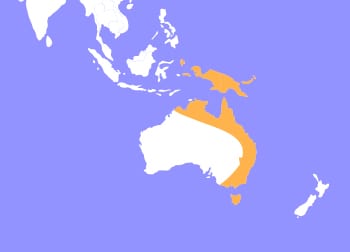Sugar Glider
Petaurus breviceps
Sugar gliders are tiny arboreal marsupials, native to Australia. These tiny gliding creatures are also omnivorous and nocturnal, being active mainly during the evening. The Sugar Gliders name refers to its preference for sugary foods such as sap and nectar, and its ability to glide through the air. They are also referred to as Sugar Bears in their native region. The sugar gliders is commonly characterized by its gliding membrane, known as the patagium. This membrane extends from its forelegs to its hindlegs, one on each side of its body. Being able to glide through the trees serves as an efficient means of reaching food and evading predators.
Sugar gliders are found throughout the northern and eastern parts of mainland Australia, Tasmania, New Guinea, and several associated isles. The sugar glider coexists with the squirrel glider, mahogany glider, and yellow-bellied glider. There isn’t much competition between these animals because they live in different niche areas and use different natural resources. Sugar gliders are typically between 9 - 12 inches, weighing between 4 - 5 ounces. The fur coat of the sugar glider is thick and soft, with the underbelly being a lighter color. The sugar gliders large eyes help it to see at night, along with adapted claws to help it grip trees.

Sugar Gliders can be found in the mainland of Australia, New Guinea, and certain Indonesian islands. It has since been introduced to Tasmania.
HABITAT -They live in the trees and forests of Australia, New Guinea, Tasmania, and certain Indonesian islands.
DIET -They are omnivorous eating mainly fruit, sap, vegetables, and insects.
FUN FACT -Torpor is energy conservative state Sugar Gliders will enter if resources are scarce or temperature is extreme.
SOCIAL BEHAVIOR -They are social animals, living in small groups of up to 7.
ACTIVITY -Sugar gliders are mostly nocturnal, being active during the evening and sleeping during the day.
PREDATORS -Predators include Kookaburras, snakes, and feral cats.
SIZE -Sugar gliders are typically between 9 - 12 inches, weighing between 4 - 5 ounces.
RELATIVES -Relatives include the squirrel glider, mahogany glider, and yellow-bellied glider.
CONSERVATION -Sugar Gliders are categorized as LC (Least Concern) species by the IUCN.
Cub Creek Animal Care Information
Housing - Our colonies of sugar gliders are housed in a large indoor enclosure where the light is regulated on a nocturnal light system. They are amazing climbers, being able to scurry around on limbs and tree branches in their enclosure. In addition to tree branches in the enclosure, there are many toys for small animals that they love to play on. Things like small hammocks, hamster wheels, and hanging toys can be found in their enclosure. We also have a colony of sugar gliders that live in the small animal room.
Diet - Just like in the wild, their diet consists of sugary fruit! They love a good mixture of apples and bananas mixed with some fruit yogurt, or the occasional mango or other sweet treat. Feeding them yogurt also helps to help with calcium deficiency, which they are prone to. Their diet is supplemented with a mixture of insects to help meet their high protein needs.
Enrichment - We provide our sugar gliders with plenty of enrichment to keep them stimulated and healthy. Our sugar gliders are accustomed to human interaction, leaping onto shoulders being quite docile in nature. This stems from continual enrichment with toys and social interaction. During the summer, campers will make all kinds of toys for them, made out of cardboard and other materials!


